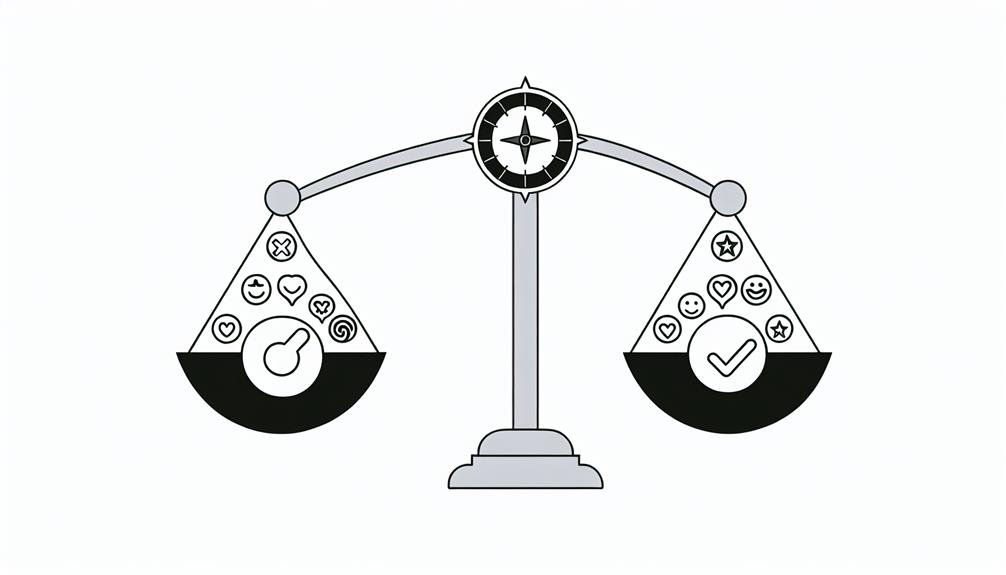Balanced Scorecard strategies can greatly boost a firm’s quality management. By aligning individual and organizational goals, these strategies drive performance and encourage continuous improvement. The use of performance metrics promotes accountability, while integrating the scorecard into the management systems allows for adaptability. Continuous monitoring and updating of the scorecard ensure accuracy, while innovative thinking helps achieve objectives effectively. Cases show numerous companies have witnessed significant improvement in efficiencies and customer satisfaction upon implementation. If you’re interested to discover these transformative strategies in detail, why not journey further into their core?
Understanding the Balanced Scorecard
To truly grasp the concept of Balanced Scorecard strategies, it is essential to first delve into understanding the Balanced Scorecard itself, a strategic planning and management system used extensively in business and industry worldwide. But hey, let’s not get lost in the jargon. Imagine you’re the captain of a ship. The Balanced Scorecard? Think of it as your compass, guiding your business vessel through the sometimes troubled waters of the commercial world. It helps you keep your eye on the ball, or should we say, the destination.
Now, when it comes to Scorecard limitations, it’s like having a compass that doesn’t quite point North. It’s a handy tool, but it doesn’t always provide a full picture. It’s not a magic solution that’ll solve all problems. It can’t predict future risks, and its effectiveness is heavily reliant on the accuracy of the data fed into it. So, it’s not foolproof.
That brings us to Scorecard alternatives. While the Balanced Scorecard is a tried-and-true method, it’s not the only game in town. Alternatives like the Performance Prism, the European Foundation for Quality Management (EFQM) Excellence Model, or the Hoshin Kanri method offer different perspectives on strategic planning. Each comes with its own merits and drawbacks, much like the Balanced Scorecard itself.
Importance of Quality Management
Quality Management is a crucial aspect of any organization that focuses on ensuring that products or services meet the established standards and customer requirements. It plays a vital role in product development by providing a framework for continuous improvement and adherence to quality standards. By implementing effective Quality Management practices, companies can enhance customer satisfaction, increase operational efficiency, and build a strong reputation for delivering high-quality products or services. In today’s competitive business environment, Quality Management is more important than ever as it helps companies differentiate themselves from competitors and maintain a loyal customer base.
Let’s unravel this concept together, peering into its role in product development and the benefits it brings. This is not just another business jargon, but a crucial pillar for a successful enterprise.
Definition of Quality Management
In the realm of business, understanding the concept of Quality Management is not just beneficial, it’s absolutely critical. So, what is it?
Quality Management, in its simplest form, is a comprehensive approach for setting an organization’s bar high – we’re talking quality standards and ensuring that these standards are met consistently (hello, Quality assurance!). It’s a systematic way of guaranteeing that your products or services are the best they can possibly be.
It’s about control, really. Control over the quality of what you offer, and in turn, control over your organization’s reputation and success.
Role in Product Development
Having established a firm understanding of Quality Management, let’s now explore its significant role in product development – a realm where quality isn’t just a nice-to-have, but a game-changer. Quality Management is the unseen force driving Product Innovation and Market Adaptability.
Here’s why:
- It ensures products are consistent and reliable. Boring? Maybe. But, predictability is sexy when you’re in control.
- It helps to reduce waste and inefficiencies, making product development a lean, mean, profit-generating machine.
- It plays a crucial role in meeting customer expectations. We’re talking about becoming the apple of your customer’s eye!
- It facilitates market adaptability. If change is the only constant, then Quality Management is your steadfast comrade in the unpredictable world of product development.
Embrace Quality Management, and let it be your secret weapon in the quest for product supremacy.
Quality Management Benefits
While it may seem like an abstract concept, embracing Quality Management can yield tangible benefits that significantly impact your bottom line. It’s not just about conforming to standards and ticking off a checklist. Quality Assurance Techniques, when implemented well, can streamline operations, avoid costly mistakes, and keep your clients coming back for more. It’s time you seize control and leverage these benefits.
The impact on Employee Morale is another key consideration. A structured approach to quality management fosters a culture of continuous improvement. When employees see their efforts contributing to a higher quality output, it boosts morale, leading to increased productivity. The correlation is undeniable. Bottom line? Quality Management isn’t an option, it’s a necessity.
Implementing Strategy-focused Management
Switching gears, let’s consider how strategy-focused management can be effectively implemented.
A closer look at aligning goals with strategy, measuring performance effectively, and the continuous improvement cycle might just reveal the key to achieving superior quality management.
Ready to unlock the potential of these elements?
Aligning Goals With Strategy
To effectively implement strategy-focused management, it’s vital to align your organization’s goals with its overarching strategy. It’s a game of chess, not checkers. You need a clear vision of the endgame, and a detailed plan to get there.
Consider these steps:
- Strategic Prioritization: Rank your goals based on their strategic impact. The higher the potential impact, the higher the priority.
- Goal Diversification: Don’t put all your eggs in one basket. Diversify your goals to spread risk and opportunity.
- Aligning Goals: Ensure every goal ties directly back to your strategy. If it doesn’t, it’s not a priority.
- Continuous Review: Regularly revisit and revise your goals to keep them aligned with your evolving strategy.
Measuring Performance Effectively
Implementing strategy-focused management necessitates effective performance measurement, a crucial aspect that directly impacts the success of your strategic goals. And here’s the kicker: you can’t ignore performance bottlenecks. They’re like silent killers, hindering progress while remaining hidden. Spot them, address them, you’re back in control.
Now, let’s talk about employee motivation. It’s not a ‘nice-to-have’; it’s the fuel that drives performance. Think about it – motivated employees are invested in their roles, driven to excel and contribute to overall success. Measure that commitment, reward it, and watch your strategic goals come to life. It’s not rocket science, it’s simply effective performance measurement. Get it right, and you’ve got a well-oiled machine that’s geared for success.
Continuous Improvement Cycle
Ever wondered how the continuous improvement cycle can supercharge your strategy-focused management? It’s time to take control and tackle the Improvement Cycle Challenges head-on.
Here’s how:
- Identify Opportunities: Seek out areas for improvement within your organization.
- Analyze and Plan: Use Cycle Efficiency Techniques to devise an effective plan for implementation.
- Execute: Implement changes based on your research and planning.
- Review and Refine: Post-implementation, review the changes, and refine as necessary.
The continuous improvement cycle is not a one-time project; it’s an ongoing process that’s integral to your growth strategy. It’s about turning problems into opportunities and driving efficiency.
Establishing Vision and Strategy
Crafting a clear vision and comprehensive strategy serves as the beating heart of effective quality management, driving all subsequent decisions and actions. Vision articulation is not a one-off task you can tick off your list after a brainstorming session. It’s an ongoing dialogue, a dynamic exchange of ideas to create a compelling picture of where your organization aims to be. It’s about dreaming big, but with a firm grounding in reality, and the courage to disrupt the status quo.
Strategy formulation, on the other hand, is where the rubber meets the road. It’s about mapping out the journey to your vision, step by meticulous step. You can’t just wing this and hope for the best. This is where you roll up your sleeves and dive into the nitty-gritty of resource allocation, risk management, and setting clear, actionable goals. It’s about making tough decisions, sometimes unpopular ones, and having the guts to stick with them.
Together, these two elements of vision and strategy are the yin and yang of quality management. They are the compass and the roadmap guiding your organization’s journey to excellence. And, they need to be in harmony. A well-articulated vision without a solid strategy is like a ship without a rudder, and a detailed strategy without a clear vision is like a rudder without a ship. Both are necessary, and both need to be continually refined and realigned as circumstances change.
Metrics for Measuring Performance
Let’s turn our attention to the crux of the matter – ‘Metrics for Measuring Performance’.
Identifying the right performance indicators and analyzing the related data can make or break your quality management initiatives.
Performance Indicator Selection
While it may seem daunting at first, the process of selecting performance indicators is a crucial step in implementing balanced scorecard strategies for effective quality management. This process involves the critical sub-steps of Indicator Prioritization and Indicator Validation.
Let’s dig in!
- Indicator Prioritization: Not all indicators are created equal. Prioritize based on relevance and impact.
- Indicator Validation: Check and re-check your indicators. Are they really measuring what you want them to measure?
- Choose Indicators that are Controllable: Indicators should reflect factors under your control.
- Balance Leading and Lagging Indicators: Mix predictive (leading) with outcome (lagging) indicators for a comprehensive view.
Analyzing Performance Data
Diving into the data, it’s imperative to understand that analyzing performance metrics is not merely about numbers, but about discerning the narrative they tell about your organization’s quality management. This isn’t your run-of-the-mill data interpretation. It’s a dynamic process of connecting dots, making sense of patterns, and comprehending the story your numbers narrate.
Performance tracking is your secret weapon, your third eye. It can reveal flaws in your quality management strategy, pinpoint areas of improvement, and highlight success. But remember, your metrics don’t define you. They’re just tools. It’s your reaction that matters. Be proactive, not reactive. Embrace the numbers, understand their language, and let them guide you to quality management mastery.
Aligning Business Processes
In the realm of quality management, the art of aligning business processes emerges as a paramount strategy to enhance operational efficiency and drive organizational success. Process optimization and stakeholder engagement, in particular, stand out as critical elements in this alignment process.
To paint a clearer picture, imagine quality management as a symphony orchestra. Each musician (or process) must perform in harmony with the rest to produce a beautiful symphony (or quality product/service). Now, if a single musician is out of tune, it disrupts the overall performance. Similarly, unaligned business processes can lead to inefficiencies, affecting the quality of the output and, ultimately, customer satisfaction.
Proper alignment of business processes involves:
- Identifying and understanding key business processes
- Analyzing and optimizing these processes
- Aligning them with the overall business strategy
- Continuously monitoring and improving them
Process Optimization is like fine-tuning your orchestra. It involves identifying bottlenecks, eliminating waste, and enhancing productivity. It’s about making sure each process is performing at its best, contributing to the overall performance.
Stakeholder Engagement, on the other hand, is like conducting your orchestra. It’s about ensuring harmonious relationships with everyone involved in the process – from employees to suppliers to customers. It involves open communication, collaboration, and mutual respect.
Finally, always remember that aligning business processes is not a one-off task. It’s an ongoing process, a journey towards continuous improvement. It’s about constantly striving for harmony, creating a symphony of success.
Up next, we will delve into ‘Enhancing Customer Satisfaction’. Stay tuned!
Enhancing Customer Satisfaction

Now, let’s shift our focus to the crucial aspect of enhancing customer satisfaction.
How, you ask?
We’ll do this by exploring the ways to measure service quality effectively, and then, taking it a notch higher, discuss how to implement robust improvement plans.
Measuring Service Quality
Let’s unravel the intricacies of measuring service quality, a critical factor in boosting customer satisfaction. By implementing a strategy focused on enhancing your service recovery methods, you can directly influence customer loyalty. Sounds straightforward, right? But it’s not just about fixing mistakes, it’s about making your customers feel valued.
- Developing a robust system to handle customer complaints and issues swiftly and efficiently.
- Initiating a feedback mechanism that allows your customers to freely voice their opinions.
- Establishing a team specifically focused on service recovery.
- Regularly evaluating your service recovery strategies to ensure they meet customer expectations.
Implementing Improvement Plans
After establishing a strong foundation in service recovery, we must turn our attention to the strategic implementation of improvement plans to further enhance customer satisfaction. Now, this isn’t some run-of-the-mill strategy we’re talking about.
We’re diving into the meaty stuff, folks. Resource allocation and employee training are the secret sauce of this endeavor. Allocating resources efficiently ensures we’re not throwing money into a black hole, and instead, pumping it into areas that directly influence customer happiness.
But what’s resource allocation without top-notch employee training? Like peanut butter without the jelly. Train your staff to be customer-centric; equip them with the skills to deliver. That’s how we take customer satisfaction from good to great.
Let’s get to it, shall we?
Role of Internal Processes
Delving into the heart of quality management, the role of internal processes becomes an integral aspect that demands our attention. It’s not just about the systems we use, it’s about how we are using them. It’s the nitty-gritty details of the day-to-day that can make or break us.
Firstly, we cannot ignore the influence of Process Automation. It has the power to streamline operations, reduce errors, and save valuable time. But automation alone isn’t a magic bullet. It’s a tool, not a solution. It’s how we use this tool that really matters.
Secondly, the importance of Employee Involvement cannot be overstated. Employees are not just cogs in a machine—they are the machine. Their knowledge, skills, and attitudes can significantly impact the success of our internal processes.
To further emphasize the role of internal processes, consider these key points:
- The effectiveness of Process Automation hinges on proper planning, implementation, and continuous improvement
- Employee Involvement is not a one-time event—it’s an ongoing commitment to engaging employees at all levels
- Efficient internal processes can lead to improved productivity and higher customer satisfaction
- The quality of internal processes can affect the organization’s reputation and bottom line
In a nutshell, internal processes are the gears that keep the quality management machine running smoothly. They may not always be visible, but their impact is undeniable. So, let’s roll up our sleeves, dive deep into these processes, and drive quality improvement from the inside out. Because quality management is not just about what we do—it’s about how we do it.
Learning and Growth Perspective
Shifting our focus to the learning and growth perspective, we uncover the transformative power of continuous development in the realm of quality management. Now, we’re not just talking about growth in terms of numbers and metrics here. Instead, we’re flipping the script to highlight the significance of employee development. Why? Because at the heart of any thriving organization is a well-equipped, constantly evolving workforce.
Growth challenges, though daunting, are instrumental in pushing the boundaries of what we know and how we do things. They can be seen as opportunities to spur innovation, improve processes, and ultimately, boost the overall quality of our output. But how do we navigate these challenges?
The answer lies in fostering a culture of continuous learning. Let’s shift our mindset from seeing employee development as a mere checkbox on our to-do list, to viewing it as a strategic tool that can propel us forward. Encourage curiosity, promote knowledge exchange, and provide avenues for skills enhancement. It’s about creating an environment where everyone, from top to bottom, is empowered to learn, innovate, and grow.
Financial Perspective in Quality Management
Turning our attention now to the financial perspective, we plunge into the world of numbers and metrics that undeniably play a pivotal role in directing quality management strategies. You see, monetary considerations are not merely an outcome of your business activities but are at the very heart of your strategic planning and decision-making processes.
Financial planning is the sword that you, as a business leader, wield to slash through the thickets of uncertainty and forge a path towards sustainable growth. It’s not just about crunching numbers, but understanding what they signify and how they can be harnessed to improve quality and efficiency.
Risk assessment, on the other hand, is your shield. It helps you anticipate potential pitfalls, evaluate their impact, and devise appropriate contingency measures. It’s the tool that allows you to navigate the stormy seas of business with confidence, knowing that you’re prepared for whatever comes your way.
Incorporating these elements into your quality management approach can yield remarkable results. To illustrate, consider the following:
- Effective financial planning helps you set realistic goals, allocate resources efficiently, and monitor progress towards your strategic objectives.
- Risk assessment enables you to identify potential threats to quality and devise strategies to mitigate them.
- Regular financial analysis can provide valuable insights into the cost-effectiveness of your quality initiatives.
- Timely financial reporting aids in making informed decisions that support continuous improvement and innovation.
Customer Perspective in the Scorecard

While financial metrics help steer the ship, understanding the customer perspective paints the picture of the destination, shaping the way businesses approach quality management. It’s the compass guiding our journey, the North Star in our quality management universe.
Now, let’s talk about customer retention. It’s the golden goose, the Holy Grail, the lifeblood that keeps our businesses pulsating. You’ve heard it before, it’s cheaper to keep a customer than to acquire a new one. But it’s not just about saving pennies. It’s about nurturing relationships, building trust, and creating loyalty.
So how do we measure this? Enter satisfaction metrics. This isn’t just a pat on the back for a job well done. It’s a diagnostic tool, a barometer of our customer’s mood. Low satisfaction scores? Red alarm bells should be ringing! High scores? Time for a celebration, right? Not so fast. Satisfaction is just the starting line, not the finish.
Think about it. A satisfied customer is not necessarily a loyal one. They might be satisfied today, but what about tomorrow? Next week? Next year? Satisfaction is fleeting. It’s a snapshot in time. But loyalty, now that’s the real deal. That’s what we’re aiming for.
Integration of Balanced Scorecard
In the quest for customer loyalty, the integration of a Balanced Scorecard can be a game changer, providing a comprehensive framework for tracking performance metrics that matter. This innovative tool can lend your organization the adaptability it needs to respond to changing business landscapes. But it’s not all smooth sailing, folks. There are limitations to every strategy, and the Balanced Scorecard is no different.
Let’s dive in and explore some key points about integrating a Balanced Scorecard:
- Scorecard Adaptability: The Balanced Scorecard is flexible, enabling businesses to adjust their metrics as market conditions evolve. It’s like a chameleon in the corporate jungle, effortlessly blending with the changing environment.
- Scorecard Limitations: However, it’s not a magical tool. Implementation can be challenging and it may not be suitable for every business model. It’s crucial to recognize these limitations and adjust accordingly.
- Integration Process: Seamlessly weaving the Balanced Scorecard into your existing management system requires careful planning. It’s like adding a new gear to a well-oiled machine – the fit must be perfect.
- Organization-Wide Adoption: For a Balanced Scorecard to work, it must be embraced across the organization. It’s not a top-down approach; everyone must be on board.
Monitoring and Updating Scorecard
Let’s now tackle the crucial task of monitoring and updating your Balanced Scorecard, a non-negotiable step in keeping your strategic compass calibrated. This is not a one-time event, but a continuous process requiring your undivided attention and commitment. You’ve got to keep your eyes on the prize, folks!
Now, the heart of the matter lies in Scorecard customization. Let’s be honest, a one-size-fits-all approach won’t cut it here. Your scorecard must be tailored to the unique needs of your organization, mirroring your strategic goals and KPIs. This is the only way to ensure a dynamic tool that truly drives performance, rather than just being another piece of dead weight.
Next up, we come to resource allocation. This is a crucial aspect to consider when monitoring and updating your scorecard. You need to ensure that the necessary resources, both financial and human, are allocated effectively and efficiently. Your scorecard shouldn’t be a drain on your resources, but a catalyst to your organizational growth.
Remember, folks, your Balanced Scorecard is a living, breathing tool. It will evolve as your organization grows, reflecting shifts in strategy and changes in the business landscape. But, here’s the kicker: You need to be the one driving this change. It’s your responsibility to continuously monitor and update your scorecard, ensuring it accurately portrays your strategic path. Don’t let it gather dust on a shelf.
In the end, it all comes down to control. Control over your strategy, control over your resources, and control over your destiny. So, roll up your sleeves and get to work. Your Balanced Scorecard isn’t going to monitor and update itself!
Transforming Organizational Performance
So, how exactly does a finely tuned Balanced Scorecard transform your organizational performance, you may wonder? The answer lies in the creation of two key elements: a Performance Culture and Organizational Innovation.
A Performance Culture is not merely about setting goals and achieving them; it’s about fostering an environment where each individual feels personally invested in the success of the organization. It’s about creating a shared vision where everyone is driven to contribute to the organization’s growth.
On the other hand, Organizational Innovation is about embracing change and encouraging creativity. It’s about leveraging the unique skills and perspectives of your team to find new and improved ways of achieving your objectives.
The Balanced Scorecard plays a central role in establishing both of these elements. Here’s how:
- Aligns individual and organizational goals: This ensures that everyone is working towards the same objectives, creating a unified front.
- Provides clear performance metrics: This gives team members a clear understanding of what is expected of them.
- Promotes accountability: This ensures that everyone is held responsible for their actions, fostering a culture of responsibility.
- Encourages continuous improvement: This fosters an environment of constant learning and growth, promoting innovation.
Case Studies of Successful Implementation
Examining real-world examples can truly illuminate the transformative power of a successfully implemented Balanced Scorecard. Let’s take a journey through the experiences of two different corporations, each with unique Scorecard pitfalls and Subtopic’s challenges.
First, we have a multinational retail giant that had been grappling with misaligned strategies and poor performance metrics. They faced the daunting task of streamlining their operations across different geographies. Their breakthrough? Implementing a balanced scorecard strategy that brought clarity and focus to their goals. After overcoming initial resistance, the scorecard strategy was embraced across all levels, resulting in improved performance metrics and a more cohesive corporate culture.
Next, we have a mid-sized manufacturing company. They were up against a wall, struggling with low productivity, high turnover, and customer dissatisfaction. Their leadership decided to take the bull by the horns and implement a balanced scorecard. The journey was not smooth. The daunting Subtopic’s challenges included the lack of a clear strategic direction and resistance from middle management. However, they held firm, found ways to overcome the Scorecard pitfalls, and finally achieved a successful implementation. Their reward? Increased productivity, reduced turnover, and a jump in customer satisfaction scores.
What do these case studies teach us? That the road to success may be littered with Scorecard pitfalls and Subtopic’s challenges. But with tenacity, a clear vision, and a balanced scorecard in hand, you can navigate your way to quality management. You see, control isn’t just about having a firm grip on the steering wheel; it’s about knowing the destination and having a map to guide you there.
Conclusion
In conclusion, the implementation of balanced scorecard strategies in quality management is not a walk in the park.
Yet, with a clear vision, strategic planning, proper integration, and consistent monitoring, it can transform any organization’s performance.
The success of this approach has been documented in various case studies, reinforcing its significance in driving organizational success and sustainability.




